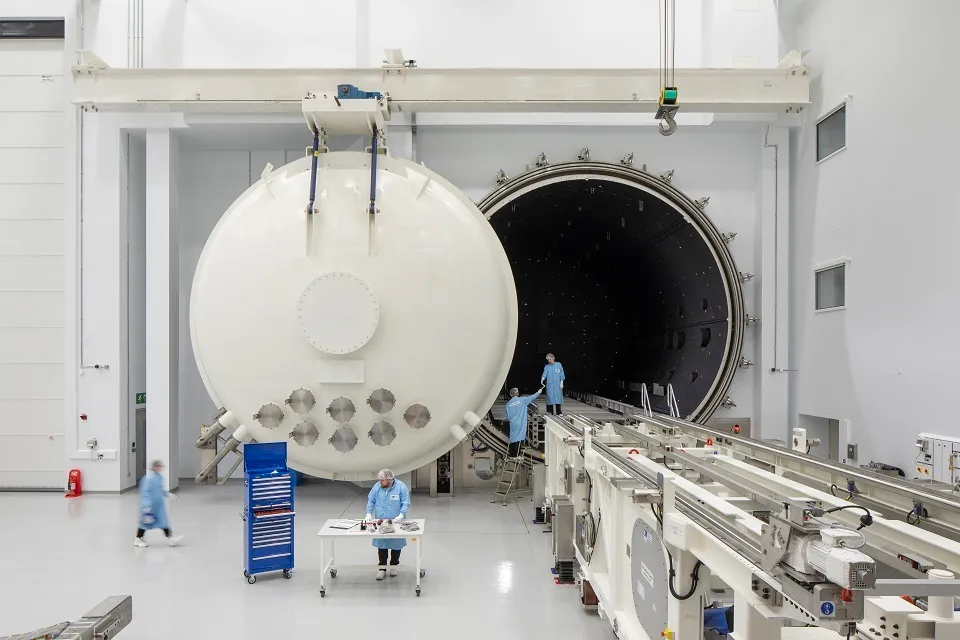
Airbus Reaches Major Milestone in Development of UK’s Next-Generation Skynet 6A Military Communications Satellite
Airbus The United Kingdom’s ambitious next-generation military satellite project, Skynet 6A, has reached a critical development milestone, signaling a major leap forward in securing future military communications capabilities. The state-of-the-art satellite, which is being designed and built by Airbus Defence and Space, has successfully undergone the complex coupling of its communications and service modules—a pivotal step in satellite integration.
This latest Airbus achievement occurred at the National Satellite Test Facility (NSTF), located in Harwell, Oxfordshire, and marks not only progress for the satellite program itself but also for the broader UK space industry. Operated by the Science and Technology Facilities Council’s (STFC) RAL Space, the NSTF has positioned itself as a central hub for advanced satellite testing and integration in the UK.
The Strategic Importance of Skynet 6A
The Airbus Skynet 6A satellite represents the next generation of secure military communications for the UK Ministry of Defence (MOD). As geopolitical threats evolve and the importance of resilient, high-capacity, and secure communications becomes paramount, Skynet 6A is being engineered to address these modern defense needs. Scheduled to enter operational service in 2027, the satellite is set to replace and significantly surpass the capabilities of the UK’s current fleet of Skynet 5 satellites.
“Skynet 6A is the next-generation, fully-hardened military satellite for the Ministry of Defence. It has three-and-a-half times the capacity of the UK’s current Skynet 5 military satellites and is due to enter service in 2027,” explained Ben Bridge, Chairman of Airbus Defence and Space UK.
Airbus Bridge emphasized that the recent integration milestone—successfully combining the service module (which houses the satellite’s power and propulsion systems) with the communications module (responsible for payload and data handling)—will allow the Airbus team to proceed with final baseline testing at its Stevenage facility, followed by comprehensive environmental testing back at the NSTF later this year.
Legacy and Innovation: The Evolution of Skynet
Airbus The Skynet program has been a pillar of the UK’s sovereign defense capability for over half a century. Since its inception in the late 1960s, Skynet has evolved from relatively modest communications satellites into one of the most advanced and secure satellite systems in the world. The current Skynet 5 constellation, in service since the mid-2000s, has provided robust, secure communications to the UK armed forces across the globe.
Skynet 6A not only builds on this legacy but represents a significant technological and strategic advancement. Designed with flexibility and upgradeability in mind, the satellite is being constructed to address the emerging needs of modern warfare, including the growing reliance on space-based assets for command, control, communication, intelligence, surveillance, and reconnaissance (C4ISR).
The new platform is also expected to offer greater resistance to cyberattacks and electromagnetic interference, reflecting the increased threat landscape in the cyber and space domains.
A Major First for the UK Space Sector
One of the most notable aspects of the Skynet 6A project is that it marks the first time a large geostationary-orbit (GEO) communications satellite has been fully integrated within the United Kingdom. This milestone showcases the growing maturity of the UK’s space sector, and highlights the country’s capability to independently develop, assemble, and test complex space assets.
“This marks a significant achievement for the Skynet 6 programme and the UK space sector as a whole,” said Barry Austin, Skynet Programme Manager at Defence Digital, part of the UK MOD. “Once operational, Skynet 6A will enhance and be critical to our Armed Forces’ military satellite communications capability and ensure they continue to receive world-class connectivity globally.”
In addition to advancing military capabilities, Skynet 6A is also fostering UK industrial growth. The project has brought together a network of domestic suppliers, research institutions, and testing facilities, creating skilled jobs and contributing to the UK’s long-term goal of becoming a global space power.
The Role of the National Satellite Test Facility (NSTF)
The NSTF at Harwell is a cutting-edge facility purpose-built to support the UK’s ambition in the space sector. It provides comprehensive environmental testing capabilities for large-scale spacecraft, including vibration, thermal vacuum, and electromagnetic compatibility (EMC) testing. As part of the UK Government’s investment in national space infrastructure, the NSTF plays a central role in enabling sovereign testing and verification of space systems.
Skynet 6A is the first spacecraft to utilize the NSTF during its inaugural operational year. Prior to the successful coupling of its modules, the satellite’s complex array of antennas underwent rigorous electromagnetic compatibility testing at the NSTF earlier this year.
“Welcoming our first customers represents a significant achievement for the NSTF, and we are proud to support Airbus with the integration and testing of Skynet 6A,” said Sean Stewart, Head of Environmental Test at RAL Space. “This milestone is a testament to the dedication of all involved and marks an exciting step for the UK as we prepare to host many more satellites of this scale.”
This partnership between Airbus and RAL Space reflects the growing synergy between government, academia, and industry in advancing British capabilities in space science and defense technology.
Strengthening Global Military Communications
Once operational, Skynet 6A will deliver secure, high-throughput satellite communication (SATCOM) services to British forces, supporting a broad spectrum of missions on land, at sea, and in the air. The satellite’s hardened design is engineered to perform in the most hostile and contested environments, including those involving electronic warfare or space-based threats.
Additionally, Skynet 6A is being developed with a flexible digital payload architecture, which allows for real-time reconfiguration of the satellite’s communications links. This will enable the Ministry of Defence to adapt to mission changes rapidly and ensure resilient coverage in dynamic operational theaters.
Beyond the UK, the Skynet 6A program also has strategic implications for allied nations. As a NATO member and close defense partner to countries such as the United States, the UK’s expanded and modernized military communications capability enhances coalition interoperability. It is expected that Skynet 6A will play a role in joint operations, peacekeeping missions, and crisis response scenarios alongside other NATO forces.
Industrial Collaboration and Workforce Development
The development of Skynet 6A is being executed across Airbus’ manufacturing sites in Stevenage and Portsmouth, where highly skilled engineers, technologists, and systems integrators are applying cutting-edge innovations in satellite technology. The Portsmouth site, which specializes in communication payloads, and the Stevenage facility, known for its expertise in satellite platforms and propulsion systems, have both been pivotal to the project’s success.
The collaboration also includes a wider UK supply chain network, drawing on the strengths of British small and medium-sized enterprises (SMEs), academic institutions, and government-backed research initiatives. This industrial base is not only critical to delivering the current satellite but also lays the groundwork for future space programs under the broader Skynet Enduring Capability (SKE) initiative, which will guide the UK’s SATCOM strategy into the 2030s and beyond.
Airbus has also invested in workforce development programs to ensure a pipeline of talent for the space and defense sectors. Through apprenticeships, graduate schemes, and partnerships with UK universities, the company is helping to cultivate the next generation of satellite engineers and mission specialists.
Environmental Testing and Launch Preparations
With the coupling milestone now achieved, the next phases for Skynet 6A include baseline functional testing at Airbus’ Stevenage site, followed by environmental testing at NSTF. These environmental trials are designed to simulate the harsh conditions the satellite will face during launch and in orbit—extreme temperatures, vibrations, and radiation exposure among them.
Once these final tests are completed and the satellite is verified for space readiness, Skynet 6A will be shipped to its launch site, with a targeted deployment timeframe set for 2026, ensuring it is fully operational and ready to replace older Skynet 5 satellites by 2027.
A New Era in UK Space and Defense
The successful integration of Skynet 6A’s core modules marks a major milestone not just for Airbus, but for the UK’s defense and space industries as a whole. This achievement underscores the country’s growing capability to deliver complex space infrastructure independently and lays a strong foundation for future collaboration, innovation, and sovereignty in critical defense technologies.
As global competition in space intensifies and satellite communications become increasingly central to military effectiveness, Skynet 6A stands as a beacon of British technical excellence, resilience, and strategic foresight.
With its next-generation capabilities, extensive testing underway, and deep collaboration between industry and government, Skynet 6A is well on its way to becoming a cornerstone of the UK’s defense communications for decades to come.




